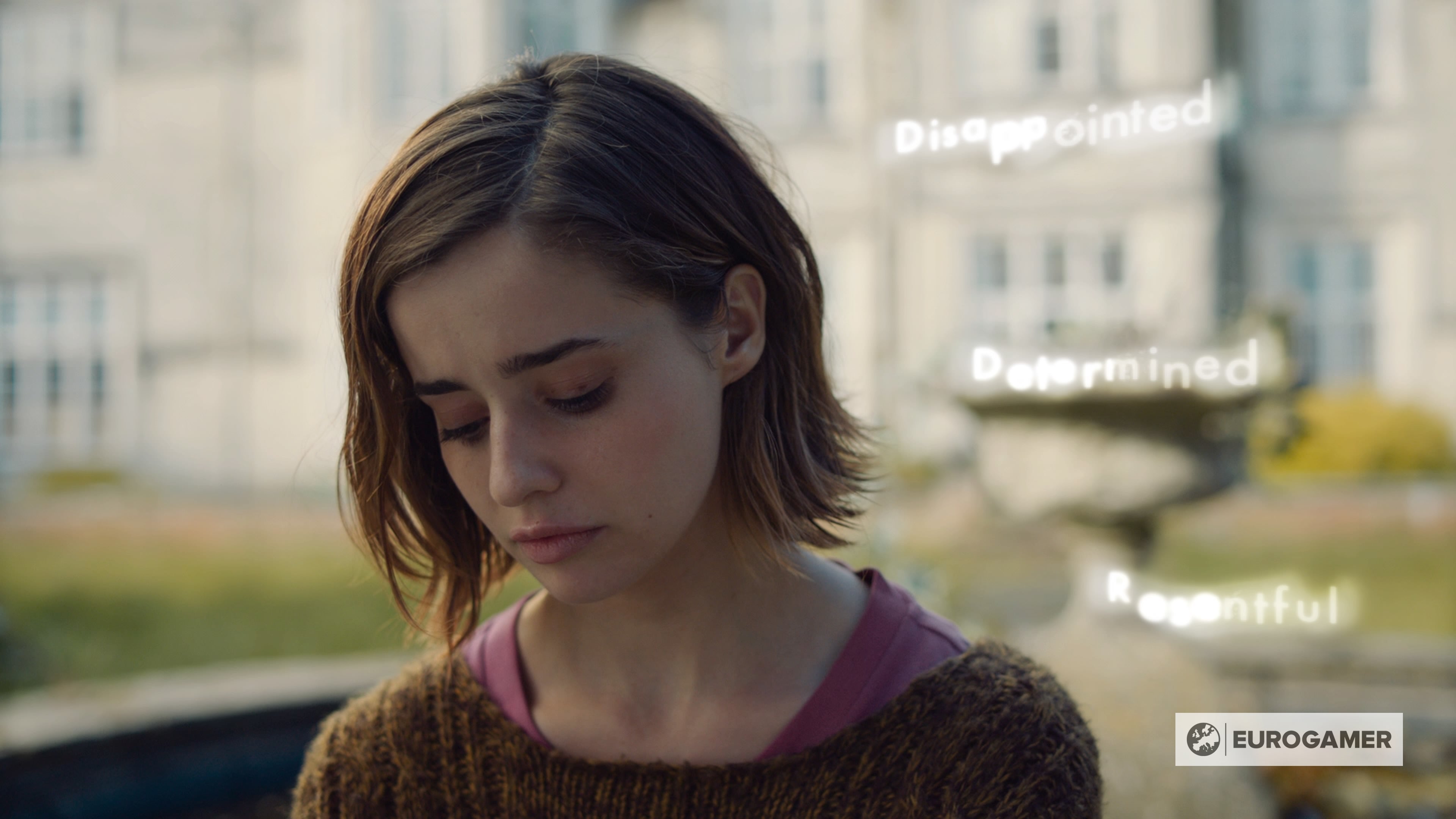But Erica was different. It had a classiness to it, and a refinement. It was beautifully shot, the acting was believable, and it was tense. And it felt different. In Erica, you could interact with the world in a more engaging way than with other FMV games. Those games tend to keep you standing back from the action, feeling as though you’re only ever choosing a film clip to watch next. But Erica pulled you in. It let you touch the world, pulling ribbons to open presents, pushing pencils across paper to draw, pressing keys to play a piano. Little things, but many things, always reinforcing that you were in this world and it was responding to you. And Erica was glossy. It had the sheen of PlayStation exclusivity and all the buzz that came with it, though it has since been released on tablets and phones, and this week on Steam. In other words, Erica seemed like a high profile revival of FMV. But as I was surprised to find out this week, it was never about that. The makers of the game don’t even like FMV. Erica wasn’t about bringing it back, it was about creating something new. The quik-ish story of Erica goes like this. In 2007, a young man called Jack Attridge noticed how cinematic games were becoming. It was a bumper year: the year Mass Effect arrived, the year BioShock arrived, the year Assassin’s Creed arrived, The Witcher, Uncharted. See? Bumper. Inspired, Attridge decided to embark on a life in games, albeit in a slightly roundabout way, by studying film. He thought those skills would persist across changing technology better, and it’s this decision which gives him the craft he’ll need to make Erica later on. Fresh out of university, he found a job at EA, and while there, pitched an idea like Heavy Rain. What he really wanted to do, even back then, was open narrative games to people who didn’t typically play them. People like his parents. He’d watched them struggle with Heavy Rain: struggle to do things in a simulation of real-life which they did easily in real-life every day. This didn’t seem right to him. “Really, it should be the other way around,” Attridge tells me. EA didn’t go for it but the seed was implanted in his mind. It wasn’t until years later, though, that the idea sprouted. He was watching an immersive theatre production called The Drowned Man, by the acclaimed company Punchdrunk, with his now business partner Pavle Mihajlovic, and they were bowled over by it. “Why are we making video games?” they said to each other afterwards. “This is amazing.” And by that, they meant: why were they making games that looked like games? Because the thing that struck them about The Drowned Man was, “It was real.” What if they could take something like that, something that looked real, and pull people into it? What if you could make someone feel like Django in Django Unchained, with his hand on the gun under the table, as his wife was being threatened in front of him? What if you could really pull people into that moment, and make the gun mechanic not binary - a do or do-not decision - but one with all the “fidelity”, as Attridge calls it, in between? What if you could gradually slide that gun as the tension built? What if they could create an experience like that? They pooled all their savings - a few hundred pounds each - and called in favours, and tried to whip up a prototype for an experience they would call Erica. They rented an Airbnb on Shaftesbury Avenue in London to film it in, and stayed up all night editing in preparation for an investor meeting the following day. That morning, though, they got a phone call that would change everything: it was Peter Molyneux. I should explain: Attridge and Mihajlovic knew Molyneux. They worked for him at 22cans. That’s where they met. They had only just left to go it alone. It had actually been a bit awkward for a moment. Molyneux had accidentally found out through Sean Murray (No Man’s Sky), of all people, they intended to leave. Murray had taken Attridge and Mihajlovic for burgers when they asked for his advice about starting up on their own. “You’re not going to be able to afford to eat soon,” he apparently said as he got the bill. And Murray hadn’t realised their leaving was a secret. Molyneux was miffed for a moment but this soon gave way to his becoming quite “parental” and coaching Attridge in his next steps. Phew. Anyway: that’s one of the reasons Molyneux was phoning. The day before, Attridge had told Molyneux he was nervous about meeting the investor. “We’re just two nobodies who are probably going to get taken for a ride,” he had said. That conversation tailed off, but now Molyneux had phoned back on the day of the investor meeting. He had actually woken Attridge up. “Hi, Jack,” he said. “So it turns out…” It turns out that Molyneux told Ian Livingstone, another British gaming legend, about the Erica prototype during their long-running Tuesday board game night. Apparently it’s been going for some 30 years, and the only award Molyneux actually displays in house, of the many he’s received, is a trophy from it. So says Attridge. Livingstone had liked what he heard, so much so he wanted to see the prototype himself. “Just come up,” Molyneux insisted, the morning of the investor meeting. So, they did, and they showed Molyneux and Livingstone the demo and waited to hear what they thought. They liked it. A lot. “In five minutes, they were like, ‘We’ll give you your starting money.’” They weren’t the only people who would be impressed. Not long after, Attridge showed an old boss who now worked at Sony, and he in turn, told his colleagues about it. “They want to talk to you,” he soon reported back. So, Attridge and Mihajlovic took their demo to Sony and, within moments, had a room full of suits up and clustered around the iPad it was playing on. “That’s the best pitch we’ve seen in years,” they apparently declared. “And before we knew it, they flew us out of San Francisco to meet Shuhei Yoshida [the then president of Sony Worldwide Studios].” They showed him the demo, “And he took the demo off me and played it himself because he wanted to make sure we weren’t cheating.” Then he asked, “How would you bring this to the living room?” The deal was made. (Later on, legendary Japanese developer Fumito Ueda would apparently turn to them and announce, “This could wake up the whole industry.”) What had caught everyone’s attention was the ability to touch the world. The ability to wipe a tear from someone’s cheek, or condensation from a window. The ability to have tactile choices, like ripping a page from a diary before giving it to someone, or either opening a door by sliding a safety chain off, or keeping it closed by sliding it on. It’s these little interactions, more than the sophisticated cinematic presentation, that are really at the heart of what Erica is about. That’s why there’s an interaction of some kind every 15 seconds, to ensure you stay in the mindset of playing and don’t slip into the mindset of watching. Game first, film second: that was their mantra, that was their difference. But they had a lot to do. They had a company to build, tech to build, and a movie to shoot and edit: a feat they somehow managed (filming excluded) with six people working in a basement. And in August 2019, their game was ready to premiere and release. Exactly how Erica did, they can’t really say, not in terms of sales. But the accumulated effect of a PlayStation Plus release a year later, and a mobile release, built them “a nice fanbase”. People send fanart, which they like. And encouragingly, it’s one of a few games that has an average playtime longer than the game. Someone has finished it 27 times, apparently. “If we can find him, we want to speak to him,” says Mihajlovic. Most importantly, Erica got Flavourworks, their studio, noticed, which helped them convince more people about their tech and ideas, and raise funding. Now, they’re more than 20 people, and have moved from the basement into an airy office in Shoreditch. And they’ve been busy, adapting their Touch Video tech for new platforms, as you know, and building new cinematic experiences to showcase what else it can do. Yes that’s right: new games. I saw one of the new games in an unfinished video. It’s described as an “action romance”, whereas Erica was a mystery thriller. In the video, a suave man in a dingy bar is eyeballed by a group of rough-looking enemies, and then a big fight breaks out. There’s a bit of London gangster about it all, and also the undeniable sheen of Erica: a kind of bluey-red tone, and a similar level of polish, of quality. But the main difference is how you interact with the world. “Erica is all about fingertips,” explains Attridge, meaning the things you do are quite delicate actions. In this game, the name of which I can’t share because it may change, it’s all about big, full-body actions. Swipe up, for example, and you flip a table. Swipe again and you smash a bowl over someone’s head. Then there’s the option to pull back the trigger on a gun. It’s pacey and stylish. It’s just one of many projects they’re doing. They mention “horror” and “comedy”, and “coming of age” experiences too, though whether these are all distinct games, I don’t know. Nor do I know how big or long each of them will be. They talk a lot about varying sizes of experience, some very short, some episode-length, and they talk about having different creators make them. It’s like a suite of different experiences. And there’s a chance we may see some of them this year. “The way we’re strategizing right now is to hit towards the end of the year with a few simultaneous previews or releases,” says Attridge They do have one bigger idea in the works, but it’s not strictly a game. “We’re developing a show with a big TV network right now,” Attridge adds, “which is really exciting, really cool. “We were like, ‘We need to make something that’s good for all mediums,’ and so we pitched something that we really loved: colourful, very different vibe.” They’ve come a long way from burgers with Sean Murray. They’d come a long way from bringing FMV back though, of course, that’s not how they’d phrase it. They’d call it “interactive live action”. They’d call it an experience like watching Punchdrunk’s The Drowned Man. And, as Mihajlovic puts it, “We want to become the best people in the world at making interactive live action of any sort.” A tall order, perhaps, but they’re off to a great start.



